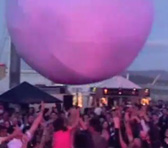31 March 2011
The Ball Project by Jon Rose
 Image: Interactive Ball at MONA FOMA festival in Tasmania
Image: Interactive Ball at MONA FOMA festival in Tasmania Jon Rose's Interactive Ball appeared for three days at the Mona Foma Festival in Hobart, Tasmania, in January 2011. Video footage of the project, shot by Rose and Garth Paine, is available on Youtube. Here, Jon Rose explains the game with 'no ref' and 'no rules'.
In recent years, the interactive ball project has moved from the set art performance to entertaining the psychology of crowd behaviour. Ask a crowd of people if they are interested in trying out an interactive violin bow, and you'd probably just receive blank looks. Most people have never held a violin, let alone undergone the pain and suffering necessary to learn how to play it with a bow. But a ball? Everyone instinctively knows what a ball is, how it works, and what to do.
Cutting an interactive ball loose into an unsuspecting crowd calls into play notions of random, chaos, loss of control. Certainly, there is a fear amongst festival managers that the crowd will become irrational, even violent - after all there is no referee and you can't have a ball game without rules or ref, can you? In three days of recent Mona Foma performances, only once did a group of kids try to hurl the ball over a fence and into the nearby Derwent River. On another occasion, the wind performed its part, whisking the ball over the top of the stage and into the windscreen of a waiting taxi and dozing driver; shock (to driver as this is Hobart) but no damage. Despite repeated urgings from festival stewards to stop the show, members of the crowd retrieved the ball, game continued, a game with no rules.
In the first 10 seconds of this crowd-ball-composer continuum, the crowd decides how the game should be played. It is suggested that the ball might retaliate if kicked, so they don't do that. They resort to surfing the ball - they must have seen it on Baudrillard's television. This is what convergence theory describes as a 'critical mass of like-minded people'. Others less generous might presume compliance rather than convergence; there are lots of ways to play with a ball and this crowd did not do that much experimenting, neither did they divide into teams or tribal groups or arm themselves for war.
They were aware, however, that they played the music of the ball, a music that could not be categorised in any sense as popular. In fact, no one has ever complained about that or asked for MOR requests, a rock act, or an Australian opera. The crowd revelled in its ability to punctuate rhythms, spin transpositions, roll out transformations of texture, and shape the very structure of the composition. They accepted the premise that if playing with a ball generates music - it could sound like this.
Further links
Jon
Rose - AMC profile
Jon Rose - Interactive
Ball (Jon Rose homepage)
© Australian Music Centre (2011) — Permission must be obtained from the AMC if you wish to reproduce this article either online or in print.
Jon Rose, with 60 years on the planet, has been for decades at the sharp end of experimental, new and improvised music on the global stage. Central to that practice have been 'The Relative Violin' project - a unique output, rich in content, realising almost everything on, with, and about the violin - and the worldwide Fence project. Least known are the relative violins - over 20 home experimental string instruments, created specifically for and in Australia. In the area of interactive electronics, Jon Rose pioneered the use of the MIDI bow in the 'Hyperstring' project in the 1980s with the Steim Institute, Amsterdam. He continues to collaborate with Steim in interactive projects often involving sport, games, or the environment. The Leonardo Music Journal of MIT Press just published his definitive history of the interactive violin bow, Bow Wow.
Comments
Be the first to share add your thoughts and opinions in response to this article.
You must login to post a comment.